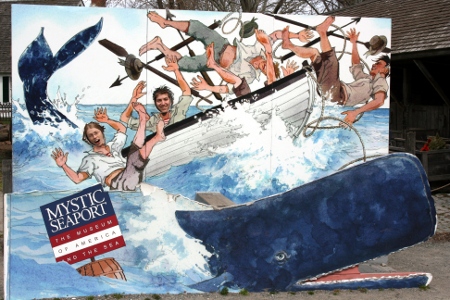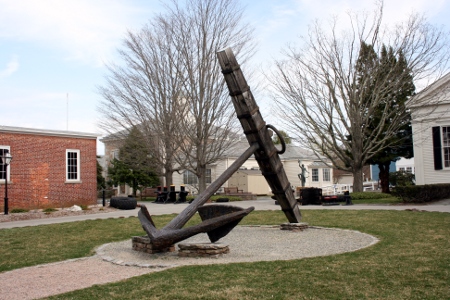This Saturday I went to Mystic, Connecticut, a small recreation of a shipbuilding and whaling town (like Williamsburg, but for mid- to late-19th century shipping). I could have easily spent another full day there and not seen everything!
A photo opportunity! On the left is my friend Matti (who I dedicated
A Lily Among Thorns to--she met me in Mystic with her fiancé, which was wonderful because I haven't seen them in forever) and on the right is me. All pictures, by the way, are taken by my uncle, David Lerner.
I really, really love tall ships.
In case you can't read this sign, it says: "1876 Witness to History: Meet a Person from the 19th Century!" And then written in chalk is "Saturday March 24, 1876. Miss Marsh is enjoying a day of respite from her work in the Mill." And then to clarify, there was this sign:
"The Staff in this exhibit are ROLEPLAYERS portraying people living in 1876. Please come in and converse with them about Life and the Sea in the 19th Century." I was a little disappointed as I was expecting time travelers!
This ginormous anchor was salvaged near Mystic and is believed to belong to a British 74-gun ship (my uncle says that was the standard size for a ship of the line) from the Revolutionary War or the War of 1812. Pretty cool, no?
I'm not sure why I found it so funny that they shrink-wrapped the boats and ships. My uncle says it's not at all unusual.
Original iron shutters on the bank! It also had an impressive iron door and a granite vault (although that was to prevent the contents being hurt in a fire, not to prevent burglaries). One thing I forgot to ask for a picture of was the partner desk in the shipping agents' office, but I really liked it. It was like two of those great sloping desks you see bankers or accountants using in costume dramas, put back to back, so that the partners could work facing each other. It's not, I guess, an unusual design, and it conserves space, but it just looked like such a cozy way to work with a friend.

The ropes had to be stretched full-length to be twisted, so to make rope for a large ship required an incredibly long building. This one, I think, wasn't even the original full length (I think they said the real one was twice as large and four times as long, or something amazing like that). The spinning wheels to make the twine was upstairs in a loft, and then as you can see, the twine went on this giant spool machine from which you could thread it into this:

(Sadly it came out a little blurry, but you get the idea). Then this machines on tracks were used to twist first the individual strands of rope, and then to twist the strands of rope together into the complete rope--but it all had to be manually told what to do by people who had to know exactly how fast to roll the machine and to rotate its parts in order to get an evenly twisted rope. Something that really struck me at all the trades was the incredible precision of every single artisan's knowledge, from the cooper who had to cut staves and form them into perfectly water-tight barrels to the ship's architects who used a wooden model of a ship to create actual full-size pieces of ships, tracing patterns for ship-parts onto the floors of giant lofts and the carpenters just carved the parts right there!
Everybody had to know exactly what they were doing or the whole thing fell apart.
This is a Life-Saving Station. Isn't the design cute? I got the impression it was the standard design. Men lived here whose job was to help out the crew of wrecked or floundering boats. They were set at intervals along the coast and the men walked a beat from their own station to the halfway point, looking out for ships in trouble. Then they could rest briefly in a small shed-like building called a halfway house. There they had to meet the guy from the next station over and exchange brass shields, to prove they had really walked the whole beat.

I was fascinated by the druggist's because of course my last hero, Solomon, was a chemist. So much neat glass equipment and mysterious jars everywhere! (All the jars in one cabinet were labeled in Latin, so the various herb-seeds were labeled "Semen" much to the amusement of some 12-year-old boys...) The druggist also equipped ships with standard medicine chests (which I think they were legally required to carry). I liked these convenient leech-jars.
The shipsmith's shop is the "only manufactory of ironwork for the whaling industry known to have survived from the 19th century." The guy working there told us the story of how it was saved: an eccentric millionaire bought it and displayed it on his estate! The man in question was
Edward Green, son of
Hetty Green (the "Witch of Wall Street," so called because I guess ladies can't be successful Wall Street moguls without resorting to congress with the devil). Both of their Wikipedia pages are well worth reading!
Anyway, the important part is that she was a notorious miser and he was a lavish spender, with famous stamp and coin collections and a fleet of nice cars in addition to his "giant historical stuff" collection. His other big purchase was the
Charles W. Morgan, the last whaling ship still extant, also now at Mystic and currently in dry-dock being restored. (It was HUGE! We had to walk up about four flights of stairs to get onto the deck. I think most of the space was reserved for barrels of whale oil though, because my uncle, who's 6'4", was hunched over and getting severely claustrophobic in the crew deck and honestly I wasn't doing much better even though I'm only 5'8".)
The guy in the shipsmith's shop said he spent every penny of his inheritance and ended bankrupt! It's not true though. He was a talented businessman and Wikipedia says his estate was valued at over 44 million dollars and his wife and sister fought a major probate court battle over it. (His wife, by the way, was a former sex worker! He waited until after his mother died to marry her.) The bankruptcy story is a better narrative though, isn't it?
We concluded the day in the shop, where I demonstrated my restraint and frugality by only buying three new books--and one was a gift! The two for me are
Black Jacks: African American Seamen in the Age of Sail by W. Jeffrey Bolster and
The Trafalgar Captains: Their Lives and Memorials by Colin White and
The 1805 Club. I dithered over that last book but in the end I couldn't resist--it consists of brief biographies of each officer who captained a ship at the Battle of Trafalgar and (what the back cover copy describes as "perhaps the most intriguing aspect of the work") locations, descriptions, and photographs of each of their graves. If I decide to take a Trafalgar Captains' Graves Tour of England, I am prepared!
I managed to resist
Trying Leviathan, about a court case in 1818 to decide whether whales were fish or not (if they were, they were subject to New York State fish oil tax) but I'm regretting it a little now...
What large historical thing would you buy if you were an eccentric billionaire?
 Yes, it’s my birthday (“for reals”, as my little sister would say), and I’m so thrilled that my Hoydens and hoyden friends are here to share it with me. If there were a way to offer cupcakes through the internet, I would be sharing pink icing with you right now. Since there doesn’t seem to be (or, if there is, it’s a jealously guarded secret in a bunker in New Mexico somewhere), I’ll just have to share words instead and leave you to acquire the cupcakes on your own.
Yes, it’s my birthday (“for reals”, as my little sister would say), and I’m so thrilled that my Hoydens and hoyden friends are here to share it with me. If there were a way to offer cupcakes through the internet, I would be sharing pink icing with you right now. Since there doesn’t seem to be (or, if there is, it’s a jealously guarded secret in a bunker in New Mexico somewhere), I’ll just have to share words instead and leave you to acquire the cupcakes on your own.























